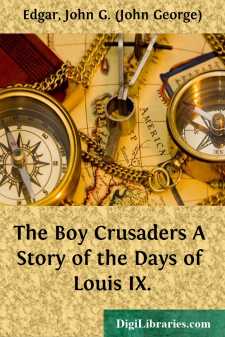Categories
- Antiques & Collectibles 13
- Architecture 36
- Art 48
- Bibles 22
- Biography & Autobiography 813
- Body, Mind & Spirit 142
- Business & Economics 28
- Children's Books 15
- Children's Fiction 12
- Computers 4
- Cooking 94
- Crafts & Hobbies 4
- Drama 346
- Education 46
- Family & Relationships 57
- Fiction 11829
- Games 19
- Gardening 17
- Health & Fitness 34
- History 1377
- House & Home 1
- Humor 147
- Juvenile Fiction 1873
- Juvenile Nonfiction 202
- Language Arts & Disciplines 88
- Law 16
- Literary Collections 686
- Literary Criticism 179
- Mathematics 13
- Medical 41
- Music 40
- Nature 179
- Non-Classifiable 1768
- Performing Arts 7
- Periodicals 1453
- Philosophy 64
- Photography 2
- Poetry 896
- Political Science 203
- Psychology 42
- Reference 154
- Religion 513
- Science 126
- Self-Help 84
- Social Science 81
- Sports & Recreation 34
- Study Aids 3
- Technology & Engineering 59
- Transportation 23
- Travel 463
- True Crime 29
The Boy Crusaders A Story of the Days of Louis IX.
Categories:
Description:
Excerpt
CHAPTER I.
A FEUDAL CASTLE.
IT was the age of chain armour and tournaments—of iron barons and barons' wars—of pilgrims and armed pilgrimages—of forests and forest outlaws—when Henry III. reigned as King of England, and the feudal system, though no longer rampant, was still full of life and energy; when Louis King of France, afterwards canonised as St. Louis, undertook one of the last and most celebrated of those expeditions known as the Crusades, and described as 'feudalism's great adventure, and popular glory.'At the time when Henry was King of England and when Louis of France was about to embark for the East, with the object of rescuing the Holy Sepulchre from the Saracens, there stood on the very verge of Northumberland a strong baronial edifice, known as the Castle of Wark, occupying a circular eminence, visible from a great distance, and commanding such an extensive view to the north as seemed to ensure the garrison against any sudden inroad on the part of the restless and refractory Scots. On the north the foundations were washed by the waters of the Tweed, here broad and deep; and on the south were a little town, which had risen under the protection of the castle, and,—stretching away towards the hills of Cheviot,—an extensive park or chase, abounding with wild cattle and deer and beasts of game. At an earlier period this castle had been a possession of the famous house of Espec; and, when in after days it came into the hands of the Montacute Earls of Salisbury, Edward III. was inspired within its walls with that romantic admiration of the Countess of Salisbury which resulted in the institution of the Order of the Garter. During the fifth decade of the thirteenth century, however, it was the chief seat of Robert, Lord de Roos, a powerful Anglo-Norman noble, whose father had been one of the barons of Runnymede and one of the conservators of the Great Charter.
Like most of the fortresses built by the Norman conquerors of England, Wark consisted of a base-court, a keep, and a barbican in front of the base-court. The sides of the walls were fortified with innumerable angles, towers, and buttresses, and surmounted with strong battlements and hornworks. For greater security the castle was encompassed, save towards the Tweed, with a moat or deep ditch, filled with water, and fortified with strong palisades, and sharp stakes set thick all around the walls. Over the moat, at the principal gate, was the drawbridge, which was almost always raised, and the gate-house, a square building, having strong towers at each corner. Over the entrance and within the square of the gate-house was an arched vault, and over it was a chamber with apertures, through which, on occasion of an assault, the garrison, unseen the whilst, could watch the operations of the foe, and pour boiling water or melted lead on the foremost assailants. On the west side were the outworks, consisting of a platform with a trench half a mile in length, and breastworks, and covered ways, and mounds....


